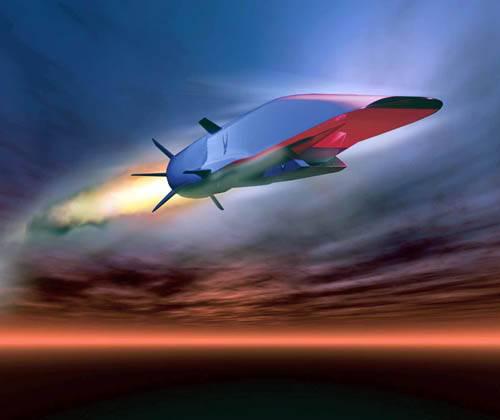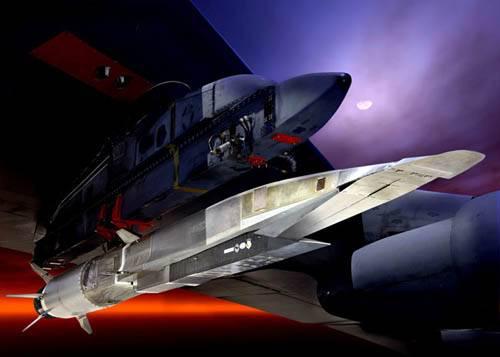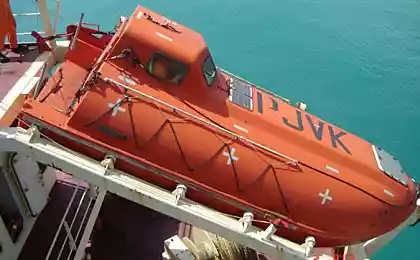525
Record "Splash": Problems of hypersonic
Last week, the regular testing of another American experimental hypersonic missiles. Set a record duration hypersonic flight, she plopped down into the ocean.

May 27 missile X-51A Waverider was dropped from the strategic bomber B-52 Stratofortress over the Pacific Ocean, south of the coast of California, from a height of just over 15 km. It has successfully launched its hypersonic jet engines accelerate to Mach 5 (about 6 thousand. Km / h), which lasted 200 seconds. This is much longer than the previous record holder, the unit X-43, which has stood for only 12 seconds.

Despite the fact that the future of X-51A has developed not so successfully, the US military issued a completely victorious reports. The head of the relevant program Brink Charles (Charlie Brink) said: "We are extremely pleased to announce the implementation of most of the tasks set before the tests. This breakthrough can be compared occurring after the Second World transition from a reactive to a spiral Aviation ».

However, officials in some places, after all, blurts. The same Brink says: "Now we have to go back and once again carefully examine all the circumstances. Ideal test does not happen, and I am sure that we will find the problem, we will try to fix for the next flight. " Independent commentators have called cautiously passed the test "partially successful».
But the problems were to be expected. Hypersonic flight - it's not even supersonic. It is believed that hypersound begins somewhere at speeds around Mach 5, and technical difficulties associated with such a frenzied movement, are very numerous. Pressure, temperature and mechanical overloads which impact on the apparatus is too high. Conventional jet engines do not provide sufficient power, and are not reliable enough. Developers poetically compared his task to the need to strike a match in the heart of the hurricane - and keep it burning.

By itself, X-51A has 4, 2 m in length, and practically devoid of wings. Technically, he is flying, riding a string of shock waves, which itself creates in flight - hence his second name, Waverider. His sharp nose he breaks the surrounding air, creating sound waves - and reflecting them under strictly defined angle. So, excessive pressure is directed at the unit, creating a lift and accelerate the flow of air entering the engine. The engine is also unusual, experimental Pratt & Whitney Rocketdyne SJY61.
These tests were third for the work on the system, and its first independent mission, as long X-51A flew only attached to the carrier aircraft. After the reset, the plane, in the first 4 seconds of flight in the X-51A conventional solid-operated engines, modified versions installed on US tactical missiles. They broke up it up to 4, 8 Mach, rising to a height of almost 20 km, and then were dropped to make room for the main - engine SJY61.

This hypersonic ramjet engine - like all such systems, it requires a high pressure in the combustion chamber, which is achieved by inhibition of the oncoming airflow. But to achieve a sufficient level of pressure flow of air itself to be supersonic, and therefore require additional overclock the machine by means of the solid propellant. It is interesting that, in contrast to his "colleagues», SJY61 runs on regular jet fuel instead of hydrogen or methane, which is achieved by using special catalysts.
Originally planned to get from the tests far more: to reach the speed of Mach 6, 300 seconds to work. But 120 seconds of information from the sensors become uneven flow (according to other data was lost traction), so that on the 200th machine was handed over to the signal at the destruction.
In any case, 200 seconds of flight at this speed - after all, a considerable success. Let's see what the tests show the following; at least 3 test launch scheduled for this year.
Of course, it is assumed that such missiles would not be a peace mission. Flying at such incredible speed, they do not require warheads, enough kinetic energy of the device.
Source:

May 27 missile X-51A Waverider was dropped from the strategic bomber B-52 Stratofortress over the Pacific Ocean, south of the coast of California, from a height of just over 15 km. It has successfully launched its hypersonic jet engines accelerate to Mach 5 (about 6 thousand. Km / h), which lasted 200 seconds. This is much longer than the previous record holder, the unit X-43, which has stood for only 12 seconds.

Despite the fact that the future of X-51A has developed not so successfully, the US military issued a completely victorious reports. The head of the relevant program Brink Charles (Charlie Brink) said: "We are extremely pleased to announce the implementation of most of the tasks set before the tests. This breakthrough can be compared occurring after the Second World transition from a reactive to a spiral Aviation ».

However, officials in some places, after all, blurts. The same Brink says: "Now we have to go back and once again carefully examine all the circumstances. Ideal test does not happen, and I am sure that we will find the problem, we will try to fix for the next flight. " Independent commentators have called cautiously passed the test "partially successful».
But the problems were to be expected. Hypersonic flight - it's not even supersonic. It is believed that hypersound begins somewhere at speeds around Mach 5, and technical difficulties associated with such a frenzied movement, are very numerous. Pressure, temperature and mechanical overloads which impact on the apparatus is too high. Conventional jet engines do not provide sufficient power, and are not reliable enough. Developers poetically compared his task to the need to strike a match in the heart of the hurricane - and keep it burning.

By itself, X-51A has 4, 2 m in length, and practically devoid of wings. Technically, he is flying, riding a string of shock waves, which itself creates in flight - hence his second name, Waverider. His sharp nose he breaks the surrounding air, creating sound waves - and reflecting them under strictly defined angle. So, excessive pressure is directed at the unit, creating a lift and accelerate the flow of air entering the engine. The engine is also unusual, experimental Pratt & Whitney Rocketdyne SJY61.
These tests were third for the work on the system, and its first independent mission, as long X-51A flew only attached to the carrier aircraft. After the reset, the plane, in the first 4 seconds of flight in the X-51A conventional solid-operated engines, modified versions installed on US tactical missiles. They broke up it up to 4, 8 Mach, rising to a height of almost 20 km, and then were dropped to make room for the main - engine SJY61.

This hypersonic ramjet engine - like all such systems, it requires a high pressure in the combustion chamber, which is achieved by inhibition of the oncoming airflow. But to achieve a sufficient level of pressure flow of air itself to be supersonic, and therefore require additional overclock the machine by means of the solid propellant. It is interesting that, in contrast to his "colleagues», SJY61 runs on regular jet fuel instead of hydrogen or methane, which is achieved by using special catalysts.
Originally planned to get from the tests far more: to reach the speed of Mach 6, 300 seconds to work. But 120 seconds of information from the sensors become uneven flow (according to other data was lost traction), so that on the 200th machine was handed over to the signal at the destruction.
In any case, 200 seconds of flight at this speed - after all, a considerable success. Let's see what the tests show the following; at least 3 test launch scheduled for this year.
Of course, it is assumed that such missiles would not be a peace mission. Flying at such incredible speed, they do not require warheads, enough kinetic energy of the device.
Source:























